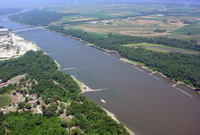Login form
Missouri River

The Missouri River has a great deal of mud in its waters. The river got its name from a Native American word meaning “dwellers of the big muddy.” Early white explorers referred to it simply as “The Big Muddy.” The nickname stuck.
THE PATH OF THE MISSOURI
The Missouri River is the longest river in the United States. It is about 2,540 miles (4,090 kilometers) long. The Missouri begins its long downstream journey in the mountains of southwestern Montana. It ends its journey by flowing into the mighty Mississippi River near the city of St. Louis, Missouri.
On its way to the Mississippi, the Missouri flows through or forms part of the border of seven states. They are Montana, North Dakota, South Dakota, Nebraska, Iowa, Kansas, and Missouri. The three largest cities along the Missouri are Omaha in Nebraska, and Kansas City and St. Louis in Missouri.
Numerous dams control the once wild river. Floods still occur, however. In 1993, the Missouri rose as high as the tops of the trees that grow along its banks in Missouri. It flooded thousands of square miles.
EARLY EXPLORERS
French missionary and explorer Jacques Marquette and French Canadian explorer Louis Joliet were the first white people to see the Missouri. That was in 1673. The river became an important route for fur traders, who over time traveled farther and farther upstream.
Meriwether Lewis and William Clark traveled the entire length of the river on their famous expedition to the Pacific Northwest from 1804 to 1806. “Immense herds of buffalo, elk, and antelopes were seen feeding in one common and boundless pasture,” the explorers noted in their journal.
AN IMPORTANT ROUTE WEST
Steamboat traffic on the Missouri began in 1819 with the voyage of the Independence. Dozens of steamboats carried settlers from St. Louis or Kansas City deep into the West during the 1800s. They also hauled freight such as grain, fur, lumber, and coal.
Steamboat travel on the river became less important after the Civil War when railroads began crisscrossing the West. Barges still carry agricultural products, steel, and oil up and down the river.
Source: Microsoft ® Encarta

